LANXESS
Hybrid Salicylate Technology Fulfills Changing Market Needs
By Mary Moon, Presque Isle Innovations, LLC | TLT CMF Plus November 2020
From machinists manipulating robotic tools to cut, grind and shape metal work pieces to operators coaxing their manufacturing equipment to run faster, end users expect premium lubricants to reliably deliver superior performance. To meet their expectations, lubricants must stay clean, which means free of dust particles, degradation by-products and other contaminants, and neutralize harmful acids. A new class of hybrid salicylate lubricant additives delivers the highest detergency and neutralizing capacity, and surpasses traditional salicylate, sulfonate and phenate detergents in terms of corrosion resistance and coefficient of friction at high temperatures. LANXESS has commercialized its first hybrid salicylate, Hybase® S220, primarily for use as an additive in metalworking fluids and industrial applications. Other new hybrid salicylate additives are in the commercialization phase for transportation lubricant applications.
LANXESS Hybase® S220
LANXESS (Cologne, Germany) is a leading global supplier of specialty chemicals. The Lubricant Additives Business supplies more than 660 synthetic base fluids, additives and fully-formulated lubricants to over 800 customers worldwide. The lubricant additive portfolio includes antioxidants, detergents, anti-wear compounds, extreme pressure additives, corrosion inhibitors, friction modifiers and automotive and industrial additive packages.
According to Su Mi Beack, Head of Product Management at LANXESS Canada (Toronto, Canada), “LANXESS is the largest independent supplier of detergent additives to lubricant producers. Our diverse sulfonate portfolio and its high quality performance differentiates us from other additive suppliers. We are very excited to scale up our novel hybrid salicylate products into the lubricants market that requires high performing additives now more than ever.”
Novel Hybrids, Not Blends
Traditional detergents include sulfonates, salicylates and phenates. In contrast, LANXESS’ premium hybrid salicylates are produced according to the company’s patent-protected synthesis, which reacts optimal overbased detergents with custom alkylated salicylic acid. LANXESS manufactures this novel alkylated salicylic acid and these hybrid salicylates on a commercial scale at its plant in West Hill (Toronto), Canada. This technology was developed at the Application Technology Center for Detergents and Grease, located on the same site in West Hill. As a result, these novel detergents are well designed and are superior to simple blends of overbased sulfonates and salicylates.
LANXESS has successfully developed premium hybrid salicylates with base numbers (BNs) up to 350 mg KOH/g , a measure of the neutralization capacity in terms of excess base, or “overbase”. This base has the ability to neutralize mineral acids, lubricant degradation by-products, and products of incomplete combustion. LANXESS has shown that its premium hybrid salicylates have multi-functional attributes beyond detergency, including oxidation control, corrosion inhibition, friction reduction and antiwear performance. These multi-functional additives can be formulated into a wide range of marine, motor oil, fuel, grease, industrial and metalworking products.
Overbased Calcium Premium Hybrid Salicylates
Hybase® S220, an overbased calcium premium hybrid salicylate with BN 220, is synthesized from a highly overbased calcium sulfonate and alkylated salicylic acid. In laboratory studies, Hybase® S220 was shown to be soluble and stable in all primary base oil types, Groups I through IV, when tested at 3.5 wt.% at 20°C for 31 days. (
Figure 1) An experimental overbased calcium hybrid salicylate (RD 310, BN 350) was soluble and stable in Groups I through IV base oils under the same test conditions. Only trace (below the ability to quantify) sedimentation was observed for both hybrid salicylates when these tests were repeated at -20 and 50°C.
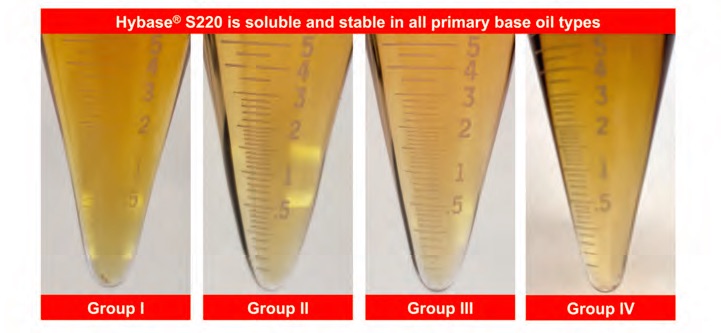 Figure 1. Stability in Base Oil – Hybase® S220
Figure 1. Stability in Base Oil – Hybase® S220
Additional laboratory studies were conducted to compare Hybase® S220 and RD 310 with traditional overbased sulfonate, salicylate and phenate detergents, a sulfonate-salicylate blend, a sulfonate-phenate additive package and two competitive calcium salicylates. (
Figure 2)
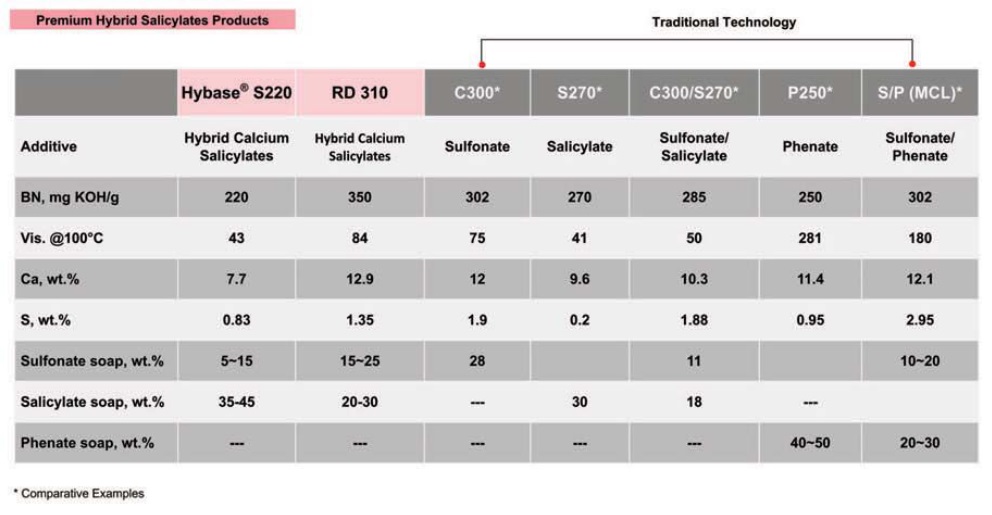 Figure 2. Premium Hybrid Salicylates vs. Traditional Technology
Figure 2. Premium Hybrid Salicylates vs. Traditional Technology
Panel Coker testing was carried out to measure detergency performance of hybrid salicylate and traditional detergent additives formulated in 500 SUS Group I oil. Test conditions were aluminum panels at 315°C, oil sump at 100°C and splash/bake 15/45 s, 4 h. Two additive concentrations were tested, 3.5 wt.% and levels to provide 4.5 BN. Overall, Hybase® S220, BN 220, and experimental RD 310, BN 350, outperformed five traditional detergents, explained Dr. James Jianjun Wei, Senior Chemist, LANXESS Canada. (
Figure 3) At 3.5 wt.%, deposits were 8 and 40 mg for Hybase®S220 and RD 310, respectively, compared to results between 11 (S 270 salicylate, BN 270) and 86 mg (C300/S270 sulfonate/salicylate blend, BN 285) for over-based detergents. Deposits for 4.5 BN formulations were 38 mg for Hybase® S220, 43 mg for RD 310, and between 30 (C 300 sulfonate, BN 302) and 173 mg (P250 phenate, BN 250) for other detergents.
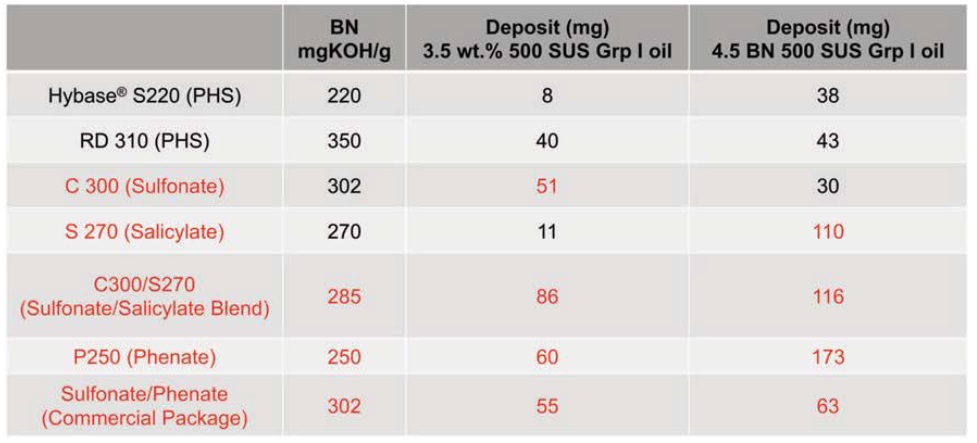 Figure 3. Detergency Performance – Panel Coking Test
Figure 3. Detergency Performance – Panel Coking Test
Corrosion resistance was evaluated using ASTM D665B in synthetic sea water. For 0.1 wt.% additive in 500 SUS Group I oil, Hybase® S220 and RD 310 passed (no spots), while all other additives failed with spots and/or rust. (
Figure 4)
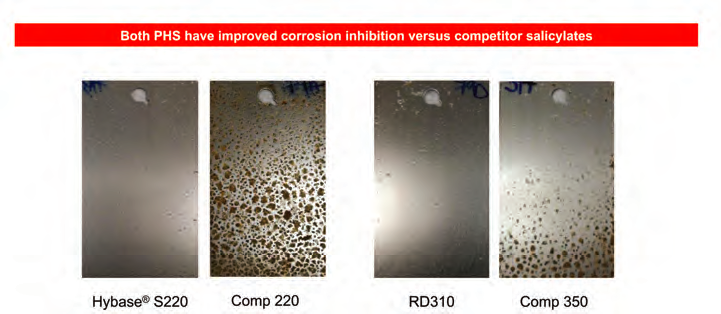 Figure 4. Corrosion Testing – Salt Fog Test
Figure 4. Corrosion Testing – Salt Fog Test
In four-ball wear testing (ASTM D2266), Hybase® S220 gave a smaller wear scar (0.43 mm) than a competitor BN 220 overbased calcium salicylate (0.47 mm). Likewise, the scar was smaller for experimental RD310 (0.46 mm) than a competitor BN 350 overbased calcium salicylate (0.54 mm). These results indicated an anti-wear advantage for LANXESS hybrid salicylates, Wei noted.
The same group of additives was formulated at 4.5 BN in finished passenger car motor oil (PCMO). Both hybrid salicylates offered better performance versus sulfonates in oxidative deposit (TEOST) tests, and equivalent or better anti-oxidation performance in two oxidative stability tests, the Rotating Pressure Vessel Oxidation Test (RPVOT) and Pressure Differential Scanning Calorimetry (PDSC).
Striking results were observed in friction tests for hybrid salicylates at 4.5 BN in PCMO with a Cameron Plint tribometer that measured coefficient of friction for a steel-on-steel contact undergoing reciprocating motion at 5 Hz with a 15 mm stroke length for a total of 90 min. As the applied load was increased from 50 to 100 N and temperature was ramped from 60 to 180°C, coefficient of friction increased or remained steady for traditional detergents but decreased steadily for both hybrid salicylates. (
Figure 5) These results revealed that Hybase® S220 and RD 310 showed an unexpected ability to reduce friction, which differentiated these materials from five traditional detergents.
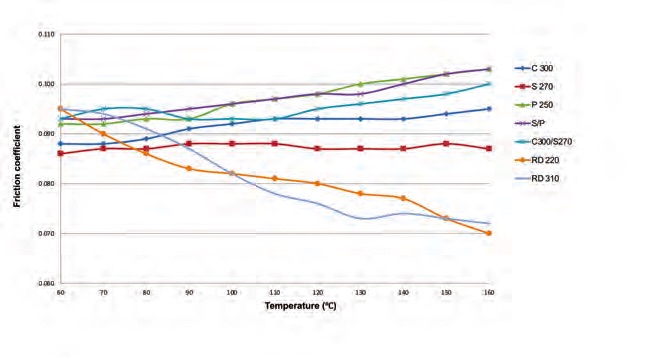 Figure 5. Premium Hybrid Salicylates – Friction Test
Figure 5. Premium Hybrid Salicylates – Friction Test
“These impressive Cameron Plint results confirm our assumption that hybrid salicylates have excellent friction and wear properties. This is an area that we will continue to investigate,” noted Wayne Mackwood, Head of Detergent and Grease Technology at LANXESS Canada (Toronto, Canada).
Hybase® S220 is recommended for use in metalworking fluids and industrial lubricants, including greases, formulated with Groups I through IV base oils. In addition to excellent detergency, this novel material performs as a multi-use additive. (
Figure 6) In standard tests, Hybase® S220 demonstrated significantly better corrosion inhibition and oxidation resistance versus traditional sulfonate detergents. Additionally, Hybase® S220 had anti-wear and friction reduction properties when formulated in Group I mineral oil and finished PCMO, respectively. An experimental overbased calcium hybrid salicylate, RD 310 with BN 350, has many of the same properties as S220 along with lower sulfur content than some sulfonates and sulfonate blends. (
Figure 2).
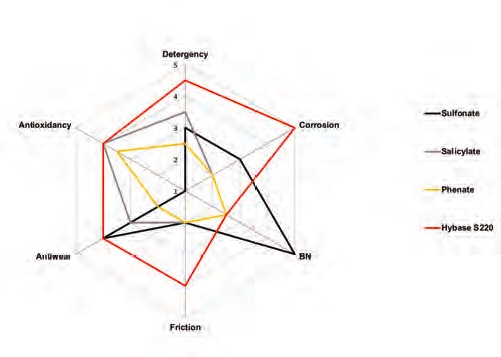 Figure 6. Hybase® S220 Summary
Figure 6. Hybase® S220 Summary
Mackwood commented, “Considerable work by Dr. James Jianjun Wei and his team went into the design of our custom sulfonate used to make RD310. As a result, the final product is highly stable in a range of base oils, including bright stock. Sediment formation was extremely low and performance remained excellent in all of the base oils examined.”
Overbased Magnesium Premium Hybrid Salicylate
LANXESS also commercialized an overbased magnesium premium hybrid salicylate with a high soap content, Hybase® MS-100 with BN between 90 and 100. Its chemistry is primarily magnesium salicylate (between 48 and 52 wt.%) along with between 4 and 8 wt.% magnesium sulfonate. Hybase® MS-100 demonstrated excellent detergency, corrosion resistance, and oxidation resistance as well as non-staining properties in laboratory tests.
Panel Coker testing was carried out with 3.5 wt.% Hybase®MS-100 in mineral oil; the result was 3.5 mg deposit. In four-ball wear testing (ASTM D4172), the wear scar was 0.56 mm for 3.0 wt.% Hybase® MS-100 in mineral oil. Water separation (ASTM D1401) was slow for 1 wt.% Hybase® MS-100 in mineral oil. In PDSC oxidation testing of 4.1 wt.% Hybase® MS-100 in PCMO at 190°C, the OIT (oil oxidation time) was 39 min.
In stability tests, 3.5 wt.% Hybase® MS-100 was soluble in four base oils, Groups I through IV. These mixtures remained stable with only trace separation at -5°C, room temperature and 50°C during 31 days.
Corrosion and staining resistance were highlights. No rust was observed for both 1.0 and 0.1 wt.% Hybase®MS-100 in mineral oil tested according to ASTM D665 (A and B) Rust Test and ASTM D1748 Rust Protection (100 h). When 10 wt.% Hybase® MS-100 in mineral oil was tested in a humidity cabinet, no corrosion was present on polished steel and aluminum test panels. No staining occurred in MIL-C-33325A for 10 wt.% Hybase® MS-100, with and without 5% water.
“Hybase® MS-100 has been shown to be a phenomenal corrosion inhibitor, rivaling even the corrosion performance of industry benchmarks such as standard barium sulfonates (Surchem™ S404 and Barinate™ B-70). On top of that, it has excellent detergency and oxidation resistance,” Mackwood concluded. LANXESS recommends Hybase® MS-100 as a possible replacement for barium sulfonate in metalworking fluids and industrial lubricants.
The information in this article is made in good faith and is believed to be accurate, but should not be used in substitution for, and does not release you from, the obligation to check its validity and test to ensure that the products, instructions, and advice is safe, effective and fully satisfactory for the intended processes and use. LANXESS disclaims all warranties, express and implied, including fitness for a particular purpose, accuracy or completeness of this information or the products, materials, processes and advice described herein.
Hybase®, Surchem™, Barinate™, LANXESS and the LANXESS Logo are trademarks of LANXESS Deutschland GmbH or its affiliates. The trademarks may be registered in many countries in the world.